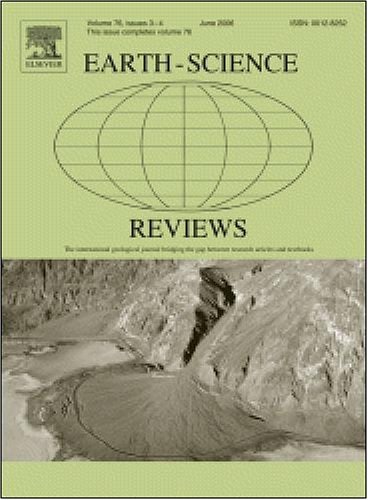Multi-scale, diverse origin inherited fabrics in rifts: A discussion through the lens of Cenozoic rifting in Thailand and comparison with other rift basins
IF 10
1区 地球科学
Q1 GEOSCIENCES, MULTIDISCIPLINARY
引用次数: 0
Abstract
Inherited fabrics in all rifts can be broadly viewed as affecting different scales of features in particular: regional rift location, rift mode, boundary faults and secondary faults. In rifts developed in relatively cold lithosphere (e.g. East African Rift) inherited fabrics are predominantly old (Precambrian), widely separated in time from rifting. Rift location is strongly linked to where lithospheric mantle strength is reduced by deep mantle processes. Conversely, in Thailand (SE Asia) Cenozoic rifting developed in hot lithosphere (upper plate of major subduction zones), inherited fabrics comprise a highly diverse range of types (folds, thrusts in Phanerozoic sequences, gneiss domes, granite plutons, metamorphic foliations, strike-slip faults) that formed primarily during the Triassic (Indosinian Orogeny), Late Cretaceous and Paleogene. The orogenic development of gneiss domes in Thailand has parallels with Caledonian structures below the northern North Sea rifts. Rift location is controlled by the area of weakest crust, i.e. the Indosinian Paleotethys suture zone. Rift mode in Thailand varies from wide to narrow to core complex not only in response to crustal conditions (temperature, thickness), but also to local magmatism and fabric inheritance (major Indosinian detachment zones). The wealth of fabrics in Thailand influenced the location, dip direction, dip value, strike orientation, propagation and linkage history, fault length-displacement characteristics, fault population size distribution and map-view patterns of normal faults. Fabric influence on Thailand's rift basins is important to identify for a variety of reasons including: 1) as an extra factor to crustal thickness and geothermal gradient that influences rift mode, 2) as a major control on rift location, 3) as means of explaining atypical fault patterns in rift basins, and thereby supporting an extensional origin, rather than an escape-tectonics related strike-slip origin, 4) as a major influence on the characteristics of individual rift basins and how structures of economic importance have developed. 5) Causing fault populations to evolve in a variety of ways during the rift initiation phase. The Cenozoic rifts of Thailand provide insights into the influence of inherited fabrics on rifting that represent near opposite end-member lithospheric conditions to the EAR.
多尺度、多样的断陷成因继承构造:以泰国新生代断陷盆地为视角探讨并与其他断陷盆地比较
所有裂谷中的继承构造可以被广泛地视为影响不同尺度的特征,特别是区域裂谷位置、裂谷模式、边界断层和次级断层。在相对寒冷的岩石圈发育的裂谷(如东非裂谷)中,继承构造主要是古老的(前寒武纪),在时间上与裂谷分离得很远。裂谷位置与岩石圈地幔强度因深部地幔作用而减弱的位置密切相关。相反,在泰国(东南亚),新生代裂谷作用发育于热岩石圈(主要俯冲带的上板块),继承构造包括高度多样化的类型(褶皱、显生宙层序逆冲、片麻岩丘、花岗岩体、变质片理、走滑断层),主要形成于三叠纪(印支造山运动)、晚白垩世和古近纪。泰国片麻岩穹丘的造山发育与北海北部裂谷下方的加里东构造有相似之处。裂谷位置受最弱地壳区域,即印支古特提斯缝合带控制。泰国裂谷模式由宽到窄不等,不仅与地壳条件(温度、厚度)有关,还与局部岩浆活动和构造继承(印支主要拆离带)有关。泰国构造丰富程度影响了正断层的位置、倾角方向、倾角值、走向、传播和联动历史、断层长度-位移特征、断层种群规模分布和图视图模式。织物对泰国裂谷盆地的影响很重要,原因有很多,包括:1)作为影响裂谷模式的地壳厚度和地热梯度的额外因素,2)作为裂谷位置的主要控制因素,3)作为解释裂谷盆地非典型断层模式的手段,从而支持伸展起源,而不是与逃避构造相关的走滑起源,4)作为对单个裂谷盆地特征和经济重要性结构如何发展的主要影响。5)导致断裂群在裂谷起始阶段以多种方式演化。泰国新生代裂谷提供了关于继承构造对裂谷的影响的见解,这些裂谷代表了与EAR几乎相反的端元岩石圈条件。
本文章由计算机程序翻译,如有差异,请以英文原文为准。
求助全文
约1分钟内获得全文
求助全文
来源期刊

Earth-Science Reviews
地学-地球科学综合
CiteScore
21.70
自引率
5.80%
发文量
294
审稿时长
15.1 weeks
期刊介绍:
Covering a much wider field than the usual specialist journals, Earth Science Reviews publishes review articles dealing with all aspects of Earth Sciences, and is an important vehicle for allowing readers to see their particular interest related to the Earth Sciences as a whole.
 求助内容:
求助内容: 应助结果提醒方式:
应助结果提醒方式:


